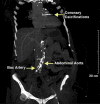Genetic pathways of vascular calcification
- PMID: 23040839
- PMCID: PMC3466440
- DOI: 10.1016/j.tcm.2012.07.002
Genetic pathways of vascular calcification
Abstract
Vascular calcification is an independent risk factor for cardiovascular disease. Arterial calcification of the aorta and coronary, carotid, and peripheral arteries becomes more prevalent with age. Genome-wide association studies have identified regions of the genome linked to vascular calcification, and these same regions are linked to myocardial infarction risk. The 9p21 region linked to vascular disease and inflammation also associates with vascular calcification. In addition to these common variants, rare genetic defects can serve as primary triggers of accelerated and premature calcification. Infancy-associated calcific disorders are caused by loss-of-function mutations in ENPP1, an enzyme that produces extracellular pyrophosphate. Adult-onset vascular calcification is linked to mutations in NTE5, another enzyme that regulates extracellular phosphate metabolism. Common conditions that secondarily enhance vascular calcification include atherosclerosis, metabolic dysfunction, diabetes, and impaired renal clearance. Oxidative stress and vascular inflammation, along with biophysical properties, converge with these predisposing factors to promote soft tissue mineralization. Vascular calcification is accompanied by an osteogenic profile, and this osteogenic conversion is seen within the vascular smooth muscle as well as the matrix. Here, we review the genetic causes of medial calcification in the smooth muscle layer, focusing on recent discoveries of gene mutations that regulate extracellular matrix phosphate production and the role of S100 proteins as promoters of vascular calcification.
Copyright © 2012 Elsevier Inc. All rights reserved.
Figures




References
-
- Allain B, Jarray R, Borriello L, Leforban B, Dufour S, Liu WQ, Pamonsinlapatham P, Bianco S, Larghero J, Hadj-Slimane R. Neuropilin-1 regulates a new VEGF-induced gene, Phactr-1, which controls tubulogenesis and modulates lamellipodial dynamics in human endothelial cells. Cell Signal. 2012;24:214–23. others. - PubMed
-
- Allam AH, Thompson RC, Wann LS, Miyamoto MI, Nur El-Din Ael H, El-Maksoud GA, Al-Tohamy Soliman M, Badr I, El-Rahman Amer HA, Sutherland ML. Atherosclerosis in ancient Egyptian mummies: the Horus study. JACC Cardiovasc Imaging. 2011;4:315–27. others. - PubMed
-
- Anderson HC. Matrix vesicles and calcification. Curr Rheumatol Rep. 2003;5:222–6. - PubMed
Publication types
MeSH terms
Substances
Grants and funding
LinkOut - more resources
Full Text Sources
Medical
Miscellaneous

